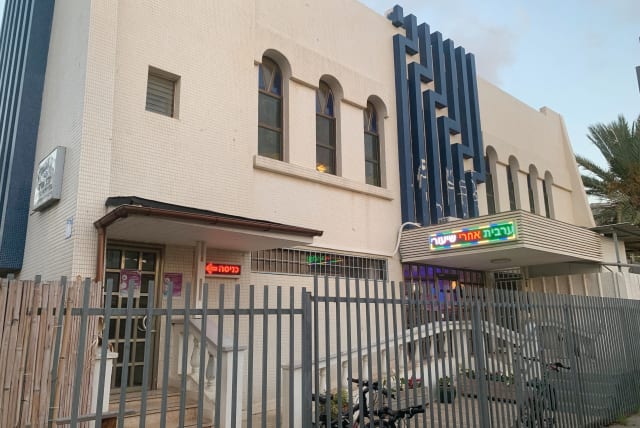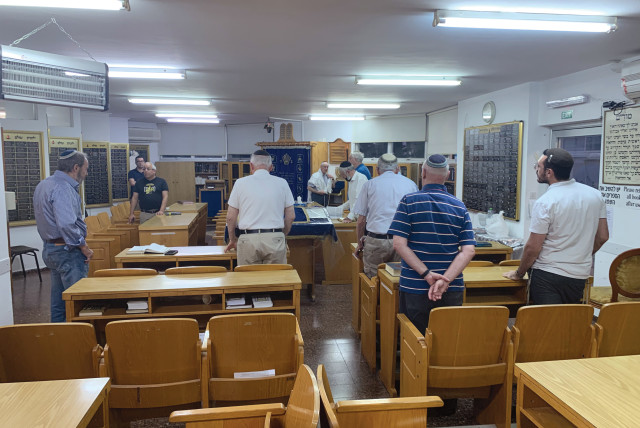Netanya: Look at all the synagogues!

Netanya’s synagogues may, in sum, be seen as not merely functional places of prayer but also communal centers.
During wartime or peacetime, a key destination for Passover season synagogue-going visitors to Israel is Netanya.
The Mediterranean city was established in 1929 and named in honor of Nathan Straus (1848-1931), co-owner of Manhattan’s Macy’s department store. The expectation was that although he donated two-thirds of his munificent personal fortunes to causes in Mandatory Palestine, there would be more money in the pipeline for this new coastal settlement. To their disappointment, it turned out that he had virtually given away all that he had, but the founders in their generosity – or possibly in their inertia – let the name stay on, as it has up to this day.
Netanya’s economy was originally based on diamonds and tourism. It has expanded in scope and variety to embrace four large industrial estates, which include Israel’s first IKEA store and a range of hi-tech companies, such as Ceedo.
With an increasing range of economic (as well as retirement) opportunities, Netanya in its pleasant coastal surroundings has continued to attract immigrants from English-speaking countries, as well as having large communities from North Africa, the former Soviet Union, and Ethiopia.
Be aware that the immigrant population outnumbers the locally born by a ratio of about 3:1, something likely to continue with the current immigration of French speakers into the city. With the surging numbers all set to pass the quarter-million mark, one would expect to find synagogues by the dozen. Yes, there are indeed some 200 officially registered such places of worship, with probably many more that informally spawned during the COVID pandemic.
The synagogues of Netanya
Yet unlike Jerusalem, for example, many of the leading synagogues are less grounded in the city’s realities and more in the communities that their immigrant congregants came from. In developing their respective turfs within this city, they perpetuate what they know and what they love, in terms of the spirit, culture, and ideals. Elements of Kiryat Sanz take you back to pre-war Romania. Neighborhoods north of the center recall Netanya’s twin city, Bournemouth, UK. Synagogues from Morocco and Tunisia are large and well appointed, expressing the character and pride of the communities that their members hailed from, as are synagogues from the former Soviet Union in the southern part of the city.
Our visit to Netanya starts on the northern shore of the city, in the Kiryat Sanz neighborhood. This remarkable district is the pioneering and creative work of Torah personality and visionary the Sanzer Rebbe, Rabbi Yekutiel Yehudah Halberstam (1905-1994), with pre-Holocaust roots in Cluj (Klausenburg), Romania. Founding Kiryat Sanz in Netanya in 1956, his was the first hassidic neighborhood in an Israeli development town. Over the next few years, he vigorously raised money and set up the establishments serving the neighborhood: the Sanzer Beit Hamidrash Synagogue and the institutions radiating from it – the yeshiva, the boys’ school, the girls’ school, the children’s home for those without family, the old-age home, and later, with the support of the Swiss banking Laniado brothers, a modern hospital complete with two medical centers, a geriatric center, and a nursing school, all currently serving the entire city and beyond, servicing a population of 500,000.
Run on strict halachic guidelines, the Laniado Hospital’s services extend to the entire region. It gave its founder, the Sanzer Rebbe, unbridled pleasure and fulfillment to see such help given to masses of people in place of the ruthless exterminations that he witnessed in the death camps and death marches in the Holocaust, where his entire family was murdered, out of which he emerged barely alive.
With the victims and casualties of the current war with Gaza and Hezbollah, Laniado is currently in high gear fundraising for life-saving medical equipment for surgical procedures, resuscitation, and increasing the number of hospital beds, with special emphasis on extracting bullets and treating bullet wounds, and also those treating injuries of evacuees living in towns close to the Lebanese border.
Moving a few blocks nearer to the city center brings you to the New Synagogue of Netanya, more generally known as McDonald’s, on the street named after James Grover McDonald, the first US ambassador to Israel. Unlike synagogues elsewhere with high numbers of English speakers and yet striving to present themselves as Israeli, McDonald’s, now in its 50th year, defines itself on its website as seeking “to create a community experience based on traditions found throughout the Diaspora. In the footsteps of our founders, we continue to provide a familiar and friendly environment where everyone, resident or guest, feels welcome. We offer daily minyanim, shiurim, kiddushim, social activities, and cultural programs. We cordially invite you to visit and join us.” I attended one of their classes after the weekday evening service, and it was expertly delivered in English rather than in Hebrew. A home away from home in Israel for English-speaking visitors.
The same applies to the rapidly growing synagogue on the other side of town: SNAC (South Netanya Ashkenazi Congregation), with a mission statement of community, commitment, and Torah, adding that the Shabbat sermon on the weekly Torah portion is in English.
All this strongly contrasts with the Frank-Sarfati Synagogue on the northern end of McDonald Street. Authentically designed for housing the Tunisian community, on my visit it was full of French speakers performing Sephardi customs, and kindergarten-age children running hither and thither. I imagined the English Channel running between the two communities.
Nearby and farther away from the coast is the impressive Heichal Rafael Synagogue on Brenner Street. Its sanctuary, with its stunning interior, made history in 2008 with its established aging population successfully insisting on wheelchair access to the main sanctuary, where they could no longer get up the stairs, which was then installed at considerable cost. This is one of many favorites for those hailing from Middle Eastern countries. Other elaborately and imaginatively designed sanctuaries from those communities include the Libyan Sha’arei Rachamim Synagogue and the more generic Sephardi-style Chessed Ve’Emet Synagogue, both major congregations in the southern half of the city.
Many other communities, such as those hailing from Iran, India, Yemen, and Ethiopia, tend to live in their geographical enclaves and have enshrined their respective heritages and customs within their places of worship. Space precludes my describing all these communities. However, a special mention should be made of immigrants from the former Soviet Union, who form a large part of the southern part of Netanya and have increasingly characterized the city.
One of their base synagogues is the Georgian Synagogue on Krinitzi Street. The Georgian community, which has a style of prayer closer to the Sephardi tradition, considered itself distinct in Tbilisi and smaller Georgian towns as, in contrast to the Ashkenazi Jews who tended to assimilate in Europe, they prided themselves on being able to continue their Jewish heritage in the face of the greatest anti-religious pressures and sanctions in the post-war decades. Things came to a head after the Six Day War, when members of that community agitated for permission to immigrate to Israel, with a substantially high proportion succeeding.
Their main community is in Ashdod, but many others made the development city of Netanya their home. Visitors can sense their values in the exhibits at the entrance to the beautiful and imposing sanctuary. There are two curly and distinctly slim shofarot – one calling to learn lessons from the past, and the other with hopes and faith for the future. And in the middle, a graphic presentation of the assembly of elders, occupied with enhancing the welfare of the community.
Netanya’s synagogues may, in sum, be seen as not merely functional places of prayer but also communal centers and foci that express the characters, customs, and cultures of the highly diverse communities who have left their countries of origin and, in many cases, lovingly and painstakingly transplanted their places of worship to the districts they have chosen to live in. Partially, this may be due to the immigrants wanting to hold on to what they know and cherish, and their belief that their ways of life in the Diaspora can find continued expression in Netanya. ■
Jerusalem Post Store
`; document.getElementById("linkPremium").innerHTML = cont; var divWithLink = document.getElementById("premium-link"); if (divWithLink !== null && divWithLink !== 'undefined') { divWithLink.style.border = "solid 1px #cb0f3e"; divWithLink.style.textAlign = "center"; divWithLink.style.marginBottom = "15px"; divWithLink.style.marginTop = "15px"; divWithLink.style.width = "100%"; divWithLink.style.backgroundColor = "#122952"; divWithLink.style.color = "#ffffff"; divWithLink.style.lineHeight = "1.5"; } } (function (v, i) { });

